How To Score Your Whitetail Buck
Measuring your buck for possible inclusion in the record book isn’t a difficult chore. This step-by-step guide will show you how.measure over the outside curve of the point so you give it the full credit it deserves."
 he date was November 14, 1987. The time 10:41 a.m. My wife Carol, who was hunting a strategic saddle in the hills of southern Indiana near our home, had just glanced over and saw a good buck coming her way. Very slowly she raised her gun, and as the 4 1/2-year-old whitetail walked through the saddle on a trail located barely 15 yards away, Carol put a slug through both of his lungs. The deer bolted, but only made it 40 yards before dying.
he date was November 14, 1987. The time 10:41 a.m. My wife Carol, who was hunting a strategic saddle in the hills of southern Indiana near our home, had just glanced over and saw a good buck coming her way. Very slowly she raised her gun, and as the 4 1/2-year-old whitetail walked through the saddle on a trail located barely 15 yards away, Carol put a slug through both of his lungs. The deer bolted, but only made it 40 yards before dying.
Naturally Carol was excited, for she had taken a mature buck, which is not all that easy to do. She also was especially excited because this deer had good brow tines, something previous bucks she had taken did not have. After I had helped her get the buster buck out of the woods, however, the age-old question arose: What does it score?
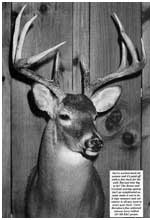 |
| A tape measure and calculator is all you need to score your buck. Carol Herndon’s fine whitetail (shown here) tallied 137 0/8 B&C points. |
I know as a measurer for the Pope & Young Club and The Longhunter Society that most of the hunters for whom I measure a buck have little knowledge of the scoring system. Therefore, as I measure each buck I explain exactly how, and why, I take each measurement and how they will be used in obtaining the final score. Each hunter then leaves with a much better understanding of how to score antlered whitetails and can practice on other bucks he or his friends have at home.
I can't bring each of you into my home to score your deer, so I will do the next best thing: I will take you step by step through the scoring process, explaining every detail you will need to know to arrive at your final tally. I will be using the Boone & Crockett system, by the way, since it has been the accepted scoring system since 1950. The Pope & Young Club and The Longhunter Society scoring system are the same as the Boone & Crockett system in case you were wondering.
Pope & Young represents bow kills, The Longhunter Society those antlered deer taken by hunters using muzzleloading rifles and Boone & Crockett entries can be those deer that were harvested by hunters using either bow or firearms. The minimum entry scores for entry into each record book is listed elsewhere.
Scoring Typical Whitetails
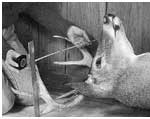 |
| Carol Herndon puts the tape to her buck’s rack to measure the greatest outside spread. Utilizing the wall as one straight edge and a ruler for the other makes this a simple process. |
The typical score is a system used to reward a deer for its symmetry, meaning everything matches up well. I call it a system to reward a deer for its beauty, and this is normally the case.
A typical point on such a buck is one projecting from the top of the main beam. All other points are considered non-typical points because they are not in the typical, or normal, location. For example, a drop tine is a non-typical point because it comes down from the bottom of the main beam. Likewise, a point coming off of another point—called a fork—is a non-typical point. Points scattered around the burr at the base of the main beam, commonly called sticker points, also are non-typical points. As are any other points in strange locations such as the side of the main beam.
To illustrate the measuring process, let's score Carol's deer since it is a good clean typical.
First of all, the definition of a point must be made before continuing. To be counted as a point, a projection must be at least one-inch long from its tip to where it joins in to the main beam or to another point. Secondly the projection must be longer than it is wide at, or somewhere past, the one-inch length measurement. This rule is to keep a long, gradual hump in a main beam from counting as a point. It also eliminates triangular projections.
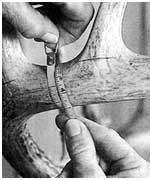 |
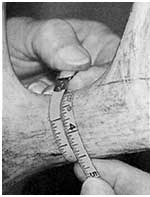 |
| The circumference measurements are best done with a measuring tape and must be performed between each tine using the smallest circumference measurement. In other words, small bumps in circumference do not qualify for inclusion. |
To clarify this, a one-inch long point, which is 1 3/8 inches wide where it joins in to the main beam, would not count as a point. On the other hand, a five inches long point that is six inches wide where it joins the main beam probably would count as a point every time. The reason is: If you come down one inch or more from its tip, very likely you would find that somewhere along the point length the length would exceed the width, thus it counts as a point.
This point determination is very important since it will be used to determine true points whether you are measuring a typical or non-typical whitetail. And in case you're wondering, the old saying about it being a point if a ring will hang on the projection is not true, nor has it ever been. Now let's examine Carol's buck.
It is very obvious by looking at her deer that it is a typical frame. All points project from the top of the main beam and all are obviously one inch in length without question. The rack is an eight-pointer, four on the right side, four on the left side. This should be recorded on the score sheet. There is a brow tine on each side. These are identified on the score chart as the G-1 points. The next matching tines out on each side are the G-2 points. The next tines out are the G-3 points, and so on, depending on how many points a deer has. Please note the end of the main beam counts as a point. This is true because we will be measuring the length of each main beam, and naturally they are over one inch in length. Now it's time to take our first measurement.
I start out by determining the greatest inside spread. This measurement counts in the score. You can use a 1 /4-inch tape measure to take this measurement, as you can all other measurements, or, if you want to spend a few dollars, you can use more sophisticated equipment. For greatest inside spread I use an extendable radio antenna I bought at a discount store and it does an excellent job.
When taking the greatest inside spread place your tape inside the main beams and try to make sure you keep the tape perpendicular to the skull. In other words, you can't measure diagonally to increase the spread. Makes sense.
Then move the tape back and forth until you find the greatest inside spread. Although official measurers have to get quite involved with this measurement at times, using squares when the main beams are tilted, you will be extremely close to what they get if you are careful in your "eye-balling". Keep in mind the inside spread credit can not exceed the length of the longest main beam.
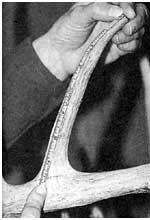 |
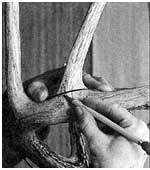 |
| Tine measurements are taken over the outside curve of the tine. It is measured from its tip to the point where it intersects the top of the main beam. To more accurately obtain this measurement; pencil in a line as shown. |
The inside spread of Carol's deer was 17 4/8 inches.
This project will cont
 Free Forum Hosting
Free Forum Hosting